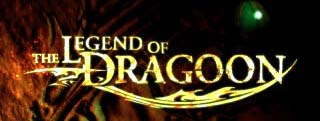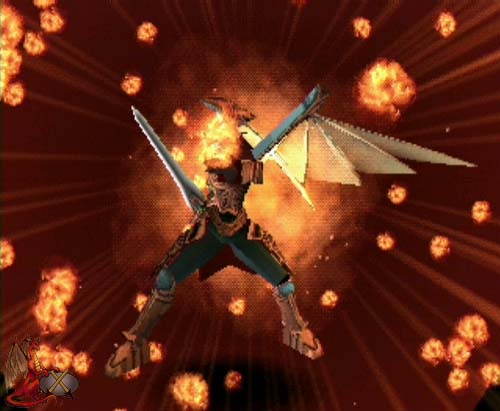|
|

|
PLATFORM
|
PSX
|
BATTLE SYSTEM
|

|
INTERACTION
|

|
ORIGINALITY
|

|
STORY
|

|
MUSIC & SOUND
|

|
VISUALS
|

|
CHALLENGE
|
Easy
|
COMPLETION TIME
|
20-40 Hours
|
|
OVERALL

|
+ Solid battle system.
+ Shiny FMVs.
- Unoriginal plot and characters.
- Music is hit-or-miss.
- Awful voice acting.
- Non-FMV graphics could have been more polished.
|
Click here for scoring definitions
|
|
|
A warrior named Dart has been pursing the Black Monster, which destroyed the town of his birth, Neet, for five years, after which he returns, unsuccessful in his search, to his current hometown, Seles, only to find it destroyed by Sandora, and that his friend Shana has been kidnapped, as well. Thus, Dart seeks to rescue her, ultimately finding himself embroiled in a long quest to hunt down a mysterious swordsman named Lloyd. Sony's The Legend of Dragoon was the product of three years of development and their attempted capitalization upon the popularity of other prominent RPGs such as Final Fantasy VII. While it does have many things going for it, Dragoon comes across as somewhat rushed despite its alleged period of development.
The battle system, fortunately, is one of said things going for the game. The arrow hovering over Dart changes color from blue to yellow to red to indicate how close the player is to an enemy encounter, a feature that very much mitigates the annoyance of random encounters, and even functions in battle to indicate how close enemies are to death, a nice convenience given the lack of scan magic. The encounter indicator, however, is absent during overworld navigation, though it isn't terribly problematic since the player won't spend a large amount of time there anyway.
In battle, the player's party of up to three characters and the enemies take turns likely depending upon agility, with commands executing right away after the player selects them, as they should in any turn-based battle system. Normal attacks, of course, are among these commands, albeit with a significant twist (one not present, however, for archer characters): Additions. As a character with this capability attacks a selected enemy, a number of swirling indicators determine when the player should press the X button. Should a player time button presses poorly, normal attacks will do pathetic damage, although good timing rewards the player with better damage.
 ...be sure to use proper grammar.
...be sure to use proper grammar.
|
|
During Additions, however, enemies can counterattack, with the swirling indicators turning red then, where the player must press the O button to ward it off and continue the Addition normally. Counterattacks can really catch players off guard and throw off Additions, and will end the Addition if the player presses the wrong button or times their button pressing poorly. Successfully completing Additions gradually builds their power, with maximum effectiveness obtained once players have performed them eighty times. Obtaining maximum levels for Additions is necessary to access each character's most powerful Addition.
Other commands include defending, which restores a tenth of a character's HP, reduces damage, and defends against status ailments until that character's next turn; using an item (with the player able to bring thirty-two consumable items into combat), escaping, or transforming into a Dragoon if that character has acquired a Dragoon Orb. Transforming into a Dragoon in the first place requires a character to have built up at least one level of SP, with maximum SP levels sporadically increasing once a player has acquired enough SP through performing Additions (or just normally attacking, in the case of archers).
In Dragoon form, a character's commands reduce to attacking or using MP-consuming magic, with new spells and increased maximum MP gained through increased SP levels. The Attack command here too requires timed button-pressing, with damage depending upon how well the player has timed his or her button presses. The number of turns in which a character remains in Dragoon form depends upon how many SP levels that character has before transformation. Moreover, if all characters, when not in Dragoon form, have a maximum number of SP levels stocked, a command becomes available to have all characters simultaneously morph into Dragoons, with the character using this option being able to use the Attack command without the need to perform timed button presses.
All in all, combat definitely has many things going for it, given the need to pay constant attention when attacking, alongside the added strategy of things such as not being able to use items while in Dragoon form and the limit on consumable items the player can carry. Battles are constantly a test of reflex, although after plenty of tries, the pattern of Additions becomes easy to pick up and master, although counterattacks can frequently throw off even the most reflexive players. In the end, there are only a small number of shortcomings, such as the general uselessness of attack items (which require a heavy degree of button mashing to be effective) and slow leveling when battling normal enemies (with most experience coming from bosses).
 Dart's flaming popcorn attack
Dart's flaming popcorn attack
|
|
Things outside battle, though, could have been a little cleaner. The interface, though, does certainly have its strong points, such as an easy menu system, easy shopping, and a generally good idea on how to advance the main storyline, with some occasional exceptions. The overworld consists of dot-connected locations, with linear travel between them. One downfall here is the inability to instantly pass beyond visited areas, sure to be an annoyance in one chapter when the player has to pass through the same area about a dozen or so times.
Also a little irritating is the odd limit of thirty-two consumable items (though space for weapons, armor, and accessories is well more than generous), with the player unable to see the contents of chests with maxed inventory space (though this does add to the effectiveness of the battle system by limiting the number of consumable items players can bring into combat), but non-healing consumable items tend to be useless, anyway. Overall, interaction could have been better, although it could have been worse, as well.
In terms of gameplay and plot, Dragoon isn't terribly inventive, since it wasn't the first RPG to feature timed button-pressing in battle (with Super Mario RPG very well predating it), although it does have some uniquenesses in this area. The story, moreover, shows a similar deficit of creativity, borrowing many elements from movies and other RPGs. In the end, the game is a hodgepodge of ideas filched from other games and media.
Dragoon's plot, however, does certainly have many things going for it, such as superb backstory and mythology providing the very foundation upon which to erect an epic storyline. The actual main storyline, however, is fairly weak and derivative, featuring a protagonist whose beloved town the enemy burns down, his childhood friend and damsel in distress, and dozens of other unoriginal characters, such as a silver-haired Sephiroth clone Dart decides to chase around, an evil emperor, and the like.
The weak localization doesn't help, either, with Dragoon's script lending the impression that middle school students wrote it, with rather simplistic sentences and scores of errors (that also occur outside the story, for instance, with some Additions having different names in and out of combat). Generally, the plot has some solid concepts, mainly its background, but weak execution in terms of present events, its derivative nature, and the shoddy writing.
 Not the best time to come out of the closet...
Not the best time to come out of the closet...
|
|
Dragoon's soundtrack is mostly hit-or-miss, with some decent tracks such as a few town themes, some of the battle themes, and some cutscene music such as the "sad" piano theme, but many weak, often out-of-place pieces as well, like many odd techno tracks such as the inventory theme and a few other battle themes, that really don't fit the game's fantasy setting. One interesting note about the battle themes, though, is that once the player has won a particular battle, the victory theme "completes" the accompanying battle theme.
Voice acting also finds its way into the game's audio, chiefly in combat, where a voice clip accompanies successful Additions, alongside the grunts up to their completion. Anyone who's seen Austin Powers will likely agree that shouting out the names of attacks does not good battle dialogue make, although characters lamentably do this for each completed Addition, and it can certainly become grating hearing these clips repeatedly. Voice acting also accompanies FMVs, although its quality there suffers, as well, with lousy lip-synching, and just about every actor, whether in battle or these cutscenes, sounding more like they're doing impersonations than actual voice acting. All in all, the game's sound could have certainly been better.
An equal mixed bag is Dragoon's visual package, which still has its high points, such as the beautiful FMVs and pre-rendered scenery, but many low points, as well. For one, the character models are fairly blocky, a step down from those in Final Fantasy VII, with the battle graphics showing an equal amount of blockiness for monsters and characters, although they nonetheless look better there. The overworld rounds out the hideous portions of the graphics, and overall, while the game doesn't have the best graphics on the Playstation, it certainly doesn't have the worst, either.
Finally, the game's length to some degree depends upon the player's skill and quickness in advancing the main storyline; this reviewer managed to finish it in a little less than forty hours, and more skilled players could possibly finish it sooner, although others may take longer.
In the end, The Legend of Dragoon doesn't quite live up to the ambitious epic that Sony promised its loyal gamers, although it's certainly not without redeeming aspects. The developers, for one, actually did a nice job putting together the battle system, an enjoyable test of reflexes. The other aspects, however, aren't quite up to par, given the rather unoriginal story, mediocre sound, and lackluster visuals largely redeemed by superb FMVs. It certainly doesn't justify its length of development, yet is still worth at least a gander, if nothing more.
Review Archives
|









